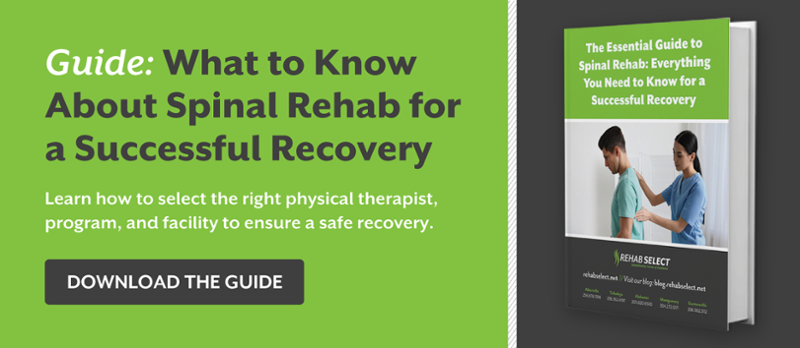
Spinal surgery is a major procedure, and proper back surgery recovery is essential for accelerating healing and minimizing complications. Physical therapy should be an integral component to help you reap the most benefits of the treatment, even if you have a minimally invasive procedure.
The goals of physical therapy for back surgery recovery are multifaceted. It aims to shorten recovery time, increase your mobility, eliminate pain and inflammation, and prevent further injury. The process strengthens and stabilizes muscles around your back and neck while preparing you for everyday activities, such as getting around and lifting objects so you can become independent as quickly and safely as possible.
Understanding the different types of physical therapy for back surgery recovery can help you find the appropriate support to meet your needs. Here's what you need to know about the different types of physical therapy exercises, how they aid recovery from back surgery, and what your physical therapist will do to ensure that you're ready for this stage of the healing process.
Types of Physical Therapy for Back Surgery Recovery
These are the most common types of physical therapy after back surgery and how they can support your healing process:
Physical Movements
Exercise is the most common type of therapy for back surgery recovery. The American Academy of Orthopaedic Surgeons recommends patients recovering from back surgery start exercising for 10 to 30 minutes one to three times daily to build up their strength.
Your physical therapist will guide you through various exercises to help you regain mobility and reduce pain. These include core and hip strengthening, cardiovascular, flexibility, and posture control routines.
Many therapists favor bodyweight exercises because they can help strengthen muscles with a lower risk of re-injury. Some equipment, such as body balls and resistance bands, can help you increase strength and range of motion at your own pace. Meanwhile, aerobic exercises are great for increasing blood flow to the spine and transporting nutrients to accelerate healing.
In some cases, your therapist may use biofeedback machines to give you immediate feedback on your movement to ensure you're achieving proper alignment and range of motion.
Massage Therapy
Message can help loosen back muscles and increase blood flow to the spinal area. In particular, a scar tissue mobilization massage can be very helpful if you experience tightness around the incision site. Your therapist may also provide instructions on how to perform massage at home regularly by yourself or with help to reduce tissue scaring over time.
If regular massage therapy isn't accessible, you can achieve some of the effects of treating scar tissue through stretching and flexibility exercises.
Pain Management
Getting off pain killers after back surgery can be challenging for some, and physical therapy can reduce inflammation that may exacerbate pain. Heat therapy helps relax muscles, while cryotherapy (or cold therapy) can reduce swelling and tenderness around the incision site. Some therapists may also perform electrotherapy and ultrasound to facilitate pain relief.
Your therapist should use these techniques alongside an exercise program to achieve long-term results and proper recovery. After all, our body signals through pain that something needs attention. If pain persists, seek advice from your orthopedic surgeon to ensure that your healing process is on track.
Injury Prevention
An important goal of physical therapy after back surgery is to help prevent future injuries and issues. Your physical therapist can show you what to avoid (e.g., some repetitive movements or twisting motions) and how to perform specific tasks safely. You'll also learn how to continue your regular exercise routine and maintain proper posture.
If your job involves physical movements or exertion, your physical therapist can give you advice on how to perform these functions safely. A therapist can also guide you to set up your home environment to minimize the chances of straining your muscles or re-injuring yourself while healing from your surgery.
When to Start Physical Therapy After Back Surgery
Most people start physical therapy four to six weeks after their back surgery. You may need to wait longer if you suffer from post-surgery complications. Your physical therapist will conduct a series of assessments to ensure you're ready.
First, the physical therapist will take your medical history to gain an overview of your healing progress. He or she will assess your posture, range of motion, and strength—focusing on the back, abdominal, hip, and thigh muscles.
Your therapist will also conduct a scar tissue assessment to ensure that these tissues aren't restricting your movements. They may test your reflexes through neurological screening and assess the flexibility of various muscle groups, including hamstrings, quadriceps, and calf muscles.
Lastly, you'll undergo functional assessments to help determine your physical therapy goal. For example, would it be realistic to expect that you can work, drive, and engage in everyday activities after your sessions? What would a full recovery look like to you?
After thorough assessments, your therapist will design a plan and decide where you'd receive the treatment—e.g., at home, the hospital, a rehab center, or an inpatient post-surgical rehab program.
The Benefits of Inpatient Rehab with Physical Therapy
Orthopedic rehab is a type of therapy that aims to restore mobility and motor function, build strength, and support recovery from injuries affecting the muscles, bones, and joints—including injuries to the spinal column and spinal cord. Your care team may combine it with occupational therapy to help you adapt to your new physical abilities.
An inpatient orthopedic rehab program conducted under professional supervision at a reputable facility is one of the best ways to help you accelerate your healing process and resume normal activities safely. In addition to receiving concentrated 24-hour care and supervision, you can also access technologically advanced care techniques, such as state-of-the-art electric nerve stimulation devices to improve nerve responsivity in the spinal cord.
Looking for physical therapy after back surgery in Alabama?
Rehab Select offers post-surgical inpatient orthopedic rehab that incorporates multiple therapies into an integrated, customized treatment plan to help shorten back surgery recovery time while improving your treatment outcomes. Our inpatient care team consists of physical therapists, occupational therapists, nurses, doctors, and other specialists whose treatments complement and build upon one another for the best results. Schedule a tour at one of our five Alabama inpatient facilities to see how we can be part of your healing journey.





